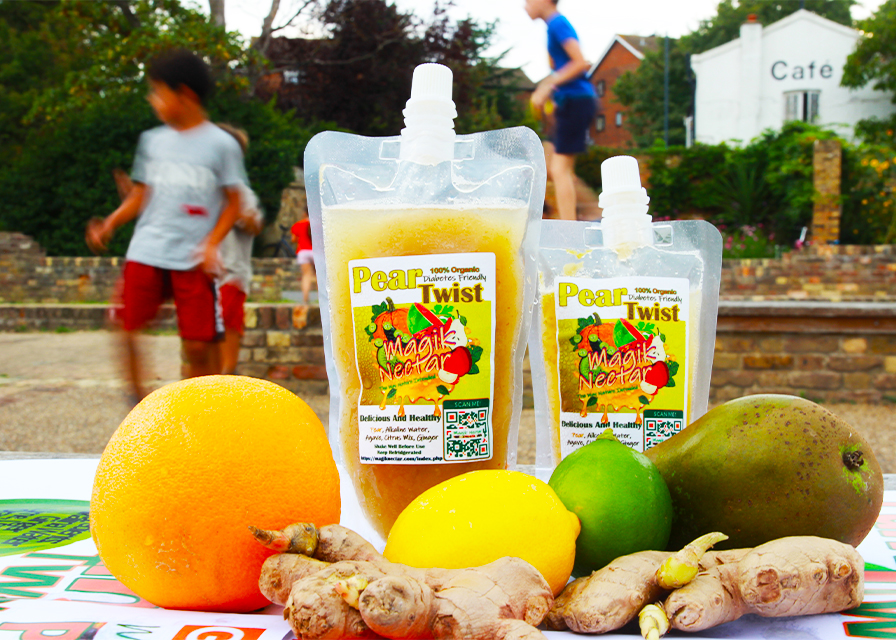Product Details

Benefits
100% Natural Pear fruit Juice
Alkaline Water
100% Natural Citrus Juice Mix
100% Natural Ginger Juice
Agave Nectar
Gluton Free
Vegan Friendly
No Sugar

Pear Twist £2.50
-
Best Quality
Standards -
Natural Healthy
Products -
The Smart
Choice
Our choices of Juice Twists were not randomly selected. The team at Magik Nectar is of the opinion that people’s immune systems are severely compromised as a result of poor dieting choices due to widespread ignorance relating to food. Simply put; we are ignorant about what our bodies require to perform at their optimum. The Magik Nectar range of Juice twists were selected specific... read more
Choose Juice Size:
Choose Quantity
-
Best Quality
Standards -
Natural Healthy
Products -
Smart Oragnic
Services
Our choices of Juice Twists were not randomly selected. The team at Magik Nectar is of the opinion that people’s immune systems are severely compromised as a result of poor dieting choices due to widespread ignorance relating to food. Simply put; we are ignorant about what our bodies require to perform at their optimum. The Magik Nectar range of Juice twists were selected specifically to address our immune requirements. We Satisfy Your Taste Buds And Your Body’s Nutritional Needs.
Pears have been a part of Eastern medicine for centuries. They play a part in helping with everything from inflammation to constipation to hangovers.
We also know that pears can help control blood sugar and lower your chances of type 2 diabetes and stroke. They can even help you digest food better.
And, as a bonus, they’re a good way to make you feel like you’ve had a small treat with some added nutrition.
How Pears Affect Blood Sugar
The glycemic index (GI) rates food and its effect on your blood sugar on a scale of 1 to 100. The higher the GI level, the faster it makes your blood sugar go up.
Pears fall between 20 and 49 on the glycemic index. That makes them a low-GI food, mostly because they’re high in fiber. One small pear has about 7 grams of it. That's as much as 20% of the fiber you need each day. (Women should get about 25 grams of fiber a day, while men should shoot for 38.)
Some studies suggest that the pigments that give pears their color, called anthocyanins, can lower your chances of type 2 diabetes. We need more research to understand why this is and how eating pears might help if you have diabetes.
Other Health Benefits of Pears
In addition to being a good source of fiber, pears are also high in vitamins C and K, as well as potassium and antioxidants. They’re also especially good for gut health, and they may help keep you regular, too.
What's more, there’s evidence that the antioxidants in fruits like pears may make you less likely to have heart disease or trouble with cholesterol.
Things to Consider
When you have diabetes, it’s always important to think about carbohydrates. A small pear has about 22 grams of carbs, which is about 1.5 servings. You’ll want to factor that in when working pears into your diet.
As with any fruit, the best way to eat a pear is to eat the whole thing. The skin is where most of the nutrients are, particularly the fiber and antioxidants. That said, be sure to wash it thoroughly before you eat it.
If fresh pears aren't a good option for you, canned ones can be a good alternative. But read the label carefully. You don't want ones packed in light or heavy syrup. That’s another way of saying “sugar added.” Instead, look for labels that say “packed in water,” “packed in their own juices,” or “100% juice.”
Dried pears keep their fiber and nutrients. But they can have a lot of sugar. Make sure to keep an eye on your serving size.
How to Get Pears Into Your Diet
They can be prepared in many ways, including, grilled, poached, or stirred into a breakfast parfait. Of course the best ways are to simply eat the fruit, juice the fruit or diced as a topping on a salad. The more natural, the better.
'Pears' That Aren't Pears
While there are many varieties of pears -- Bartlett, Anjou, and Bosc are among the most common -- some things with the word “pear” in their names aren’t pears at all. While it does have a lot of fiber and experts say it could help with blood sugar, the prickly pear is the fruit part of a type of cactus found mostly in the American Southwest and Mexico.
The balsam pear is also high in fiber, but it more closely resembles a cucumber, with its oblong shape and rough texture. They’re common in China and India, where people call them “bitter cucumbers.

